Terry L. Ettinger Horticulture Consulting Services
Meeting The Needs Of Today With A Vision For The Future
Question of the Week
How to Prune Flowering Shrubs
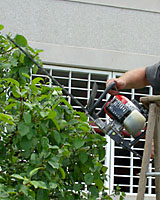 Q. There are several overgrown lilacs, forsythia and bridalwreath in my yard that need to be brought under control.
When is the best time of year to prune these shrubs? I want to keep them all about four feet tall, if possible?
Q. There are several overgrown lilacs, forsythia and bridalwreath in my yard that need to be brought under control.
When is the best time of year to prune these shrubs? I want to keep them all about four feet tall, if possible?
A. The primary tool of destruction many gardeners weld when doing battle with overgrown shrubs are hedge shears - basically a set of over-sized scissors. In fact, hedge shears - whether manual, electric or gas-powered - may be the only pruning tool found in many sheds and garages?
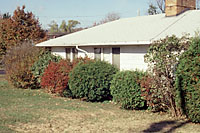 Unfortunately, using hedge shears to reduce the size of overgrown shrubs
usually creates a "crust" of nubby shoots. These shoots, in turn,
shade the lower half of the shrub, resulting in bare stems.
Ultimately, shearing turns
shrubs into stiff cubes and rectangles that don't evenly remotely
resemble their graceful, natural form!
Unfortunately, using hedge shears to reduce the size of overgrown shrubs
usually creates a "crust" of nubby shoots. These shoots, in turn,
shade the lower half of the shrub, resulting in bare stems.
Ultimately, shearing turns
shrubs into stiff cubes and rectangles that don't evenly remotely
resemble their graceful, natural form!
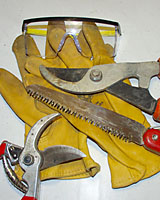 For this reason, hedge shears aren't at all useful if you want to prune lilacs, forsythia, rhododendrons and other
spring-flowering shrubs correctly. Rather, the best tools for attacking overgrown shrubs are long-handled loppers,
a small pruning saw, and well-built hand pruners. Oh, and let's not forget a good pair of gloves - and, especially,
eye protection!
For this reason, hedge shears aren't at all useful if you want to prune lilacs, forsythia, rhododendrons and other
spring-flowering shrubs correctly. Rather, the best tools for attacking overgrown shrubs are long-handled loppers,
a small pruning saw, and well-built hand pruners. Oh, and let's not forget a good pair of gloves - and, especially,
eye protection!
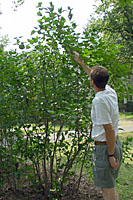 To selectively tame overgrown shrubs, begin by identifying those branches that give the plants most of their height and
width. In the case of lilacs, for example, a single stem/trunk beginning right at the ground can soar high above rest of the
plant, at left.
To selectively tame overgrown shrubs, begin by identifying those branches that give the plants most of their height and
width. In the case of lilacs, for example, a single stem/trunk beginning right at the ground can soar high above rest of the
plant, at left.
Once you’ve identified those branches giving your plants too much height or spread, follow them to the ground and remove
them with loppers or a pruning saw immediately after their flowers
fade, below. 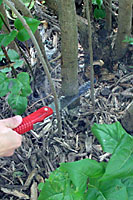 Start with stems that are that are obviously dead, or nearly so,
then move on to stems that are rubbing against each other.
Start with stems that are that are obviously dead, or nearly so,
then move on to stems that are rubbing against each other.
A general rule of thumb when selectively pruning flowering shrubs in this manner is to remove one-third of the largest, oldest stems every year. When you’re finished, there should be two to three inches between each of the remaining stems which, in turn, should be roughly between the diameter of a pencil, and one to two inches.
Finally, having outlined how to prune the shrubs that are of concern to you, I have to say that your desire to keep them no taller than four feet isn't very practical, as all three will grow to heights of at least ten feet.
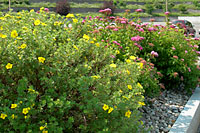 Rather,
my recommendation would be to replace them with plants that only
grow four feet tall. One recommendation would be a combination of
`Goldfinger' potentilla and `Anthony Waterers' spirea, at left.
Rather,
my recommendation would be to replace them with plants that only
grow four feet tall. One recommendation would be a combination of
`Goldfinger' potentilla and `Anthony Waterers' spirea, at left.